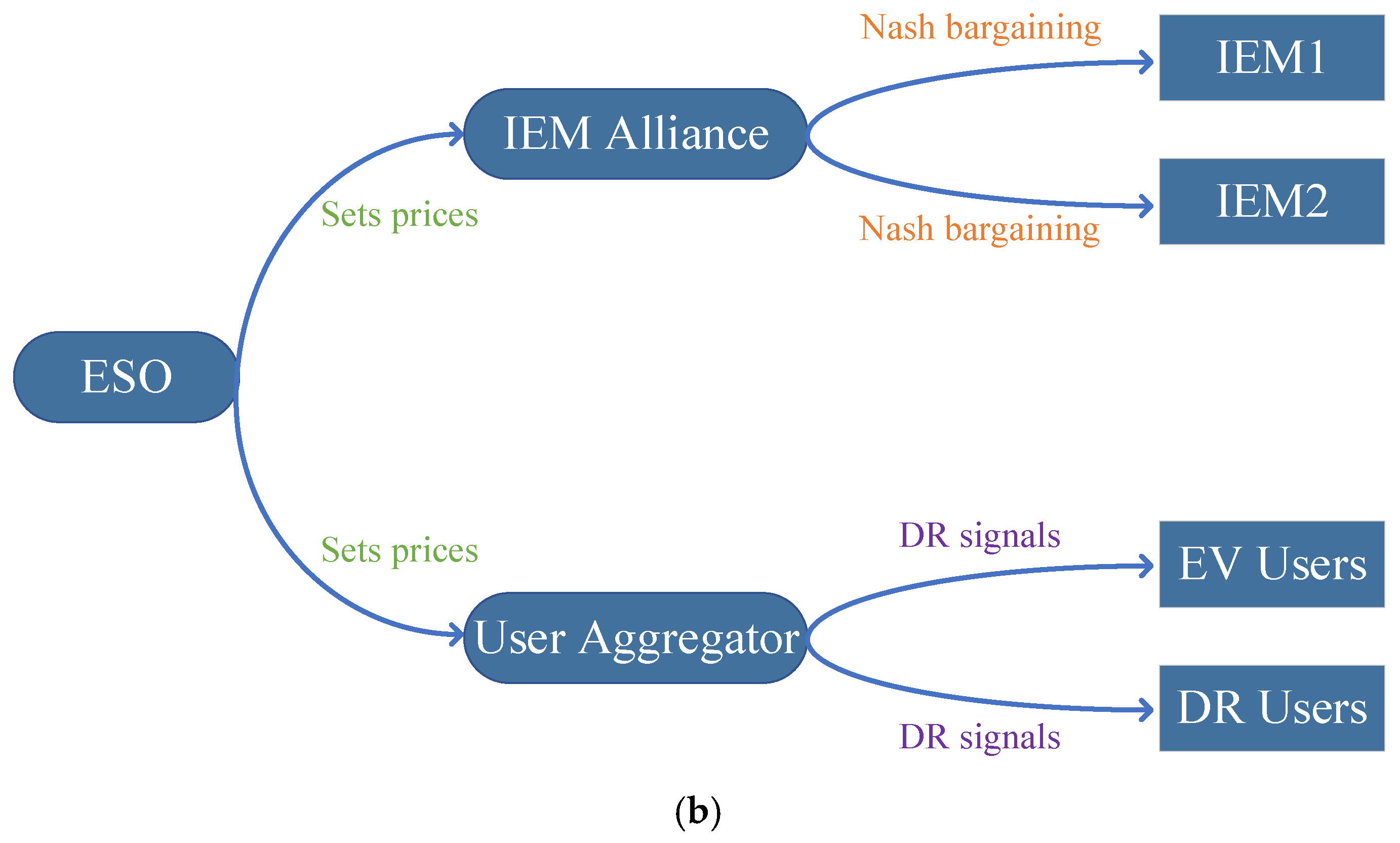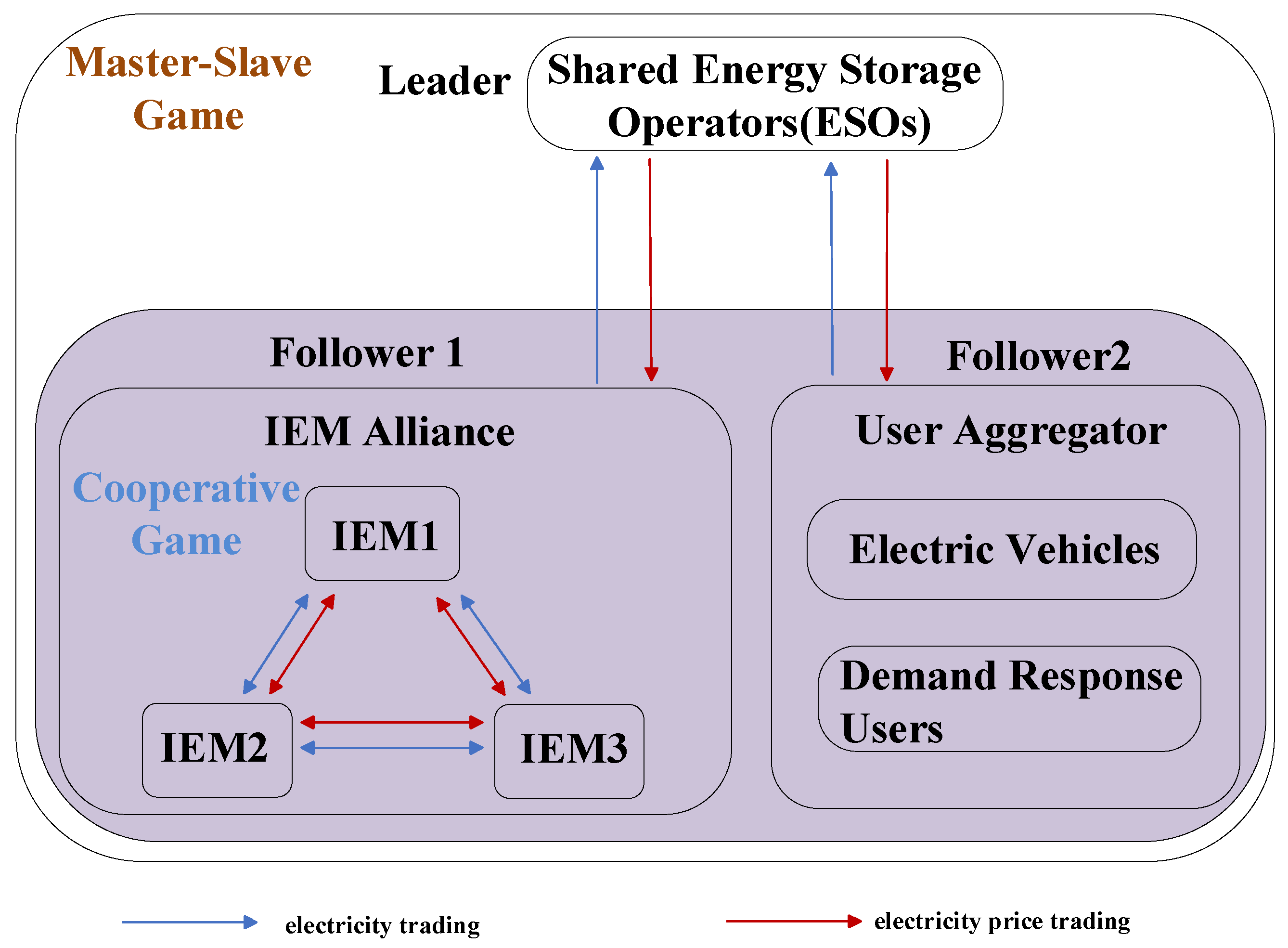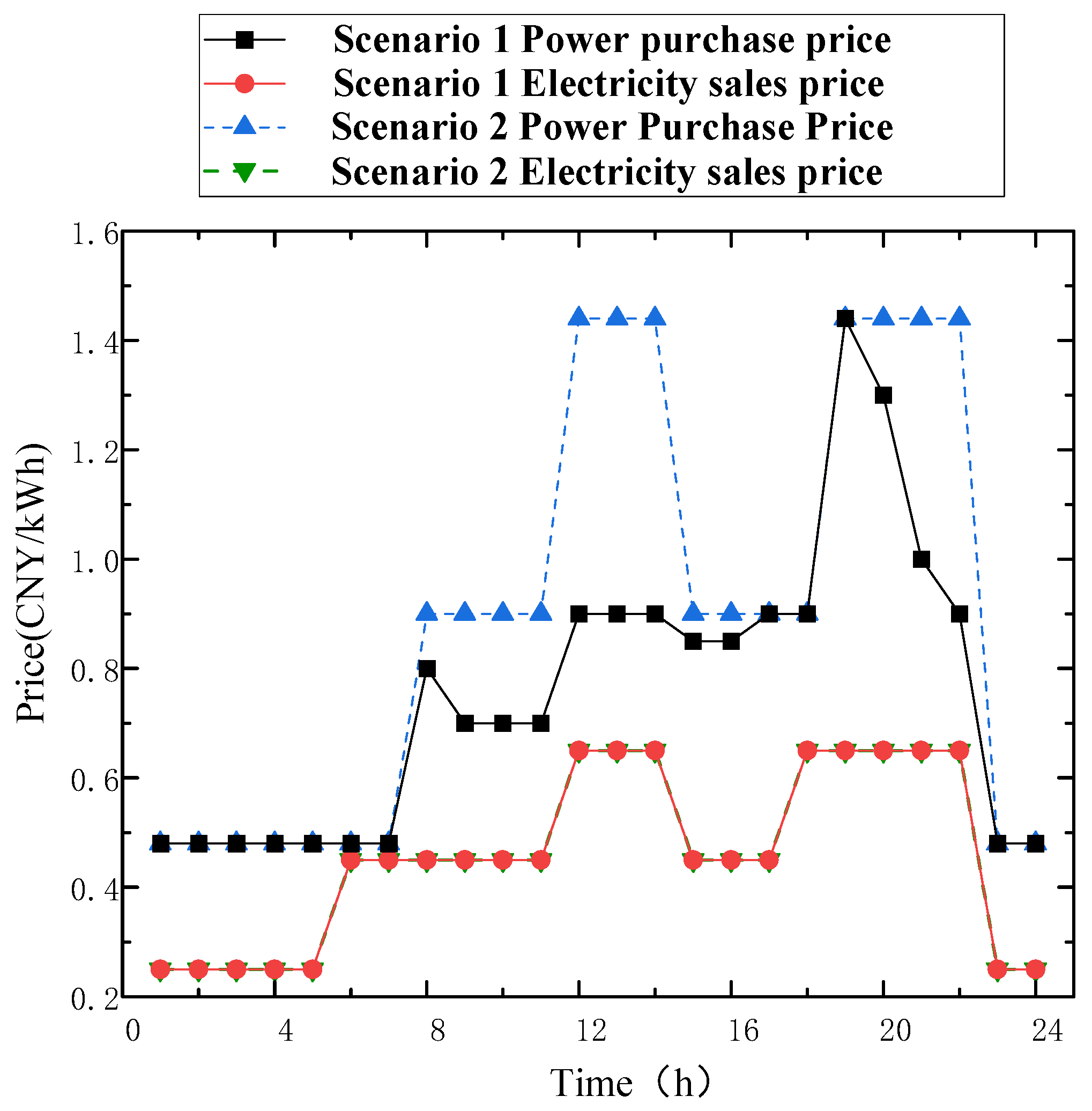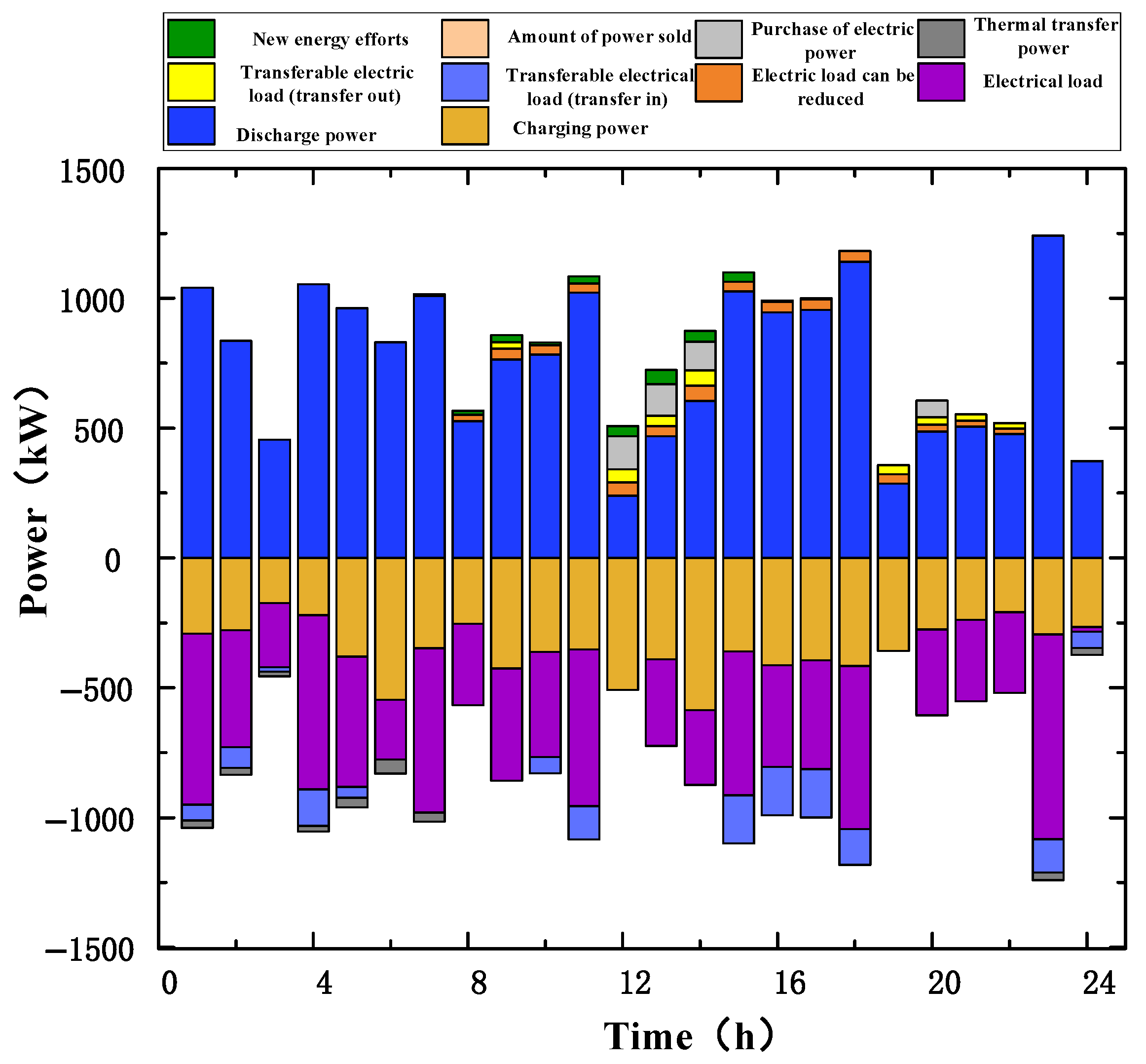Optimal Scheduling of Hybrid Games Considering Renewable Energy Uncertainty
Abstract
1. Introduction
2. System Modeling Framework
2.1. System Framework
2.2. Two-Tier Hybrid Game Optimization Framework
- (1)
- The ESO engages in a master–slave game with the IEM Alliance and the user aggregator, where all three parties aim to maximize their respective benefits. Through this interaction, the electricity trading prices and power volumes among them are determined, along with the internal power trading volumes among IEM Alliance members.
- (2)
- Using Nash bargaining theory, the cooperative game problem within the IEM Alliance is decomposed into two subproblems: the aggregator benefit maximization problem and the cooperative benefit allocation problem. Based on the electricity trading volume obtained in step 1, the internal electricity trading price between IEMs is derived according to Nash bargaining principles.
3. Shared Energy Storage Multi-Microgrid Hybrid Game Model with Multiple Types of User Aggregators
3.1. ESO Model for Game Leaders
- (1)
- Objective function
- (2)
- Constraints
3.2. Game Follower IEM Aggregate Modeling
- (1)
- Objective function
- (2)
- Constraints
3.3. Game Follower User Aggregator Modeling
3.3.1. Model of EV Charging Station
3.3.2. DR User Model
3.3.3. User Aggregator General Model
3.4. IEM Alliance Nash Negotiation Model
3.4.1. Subproblem 1: Aggregate Benefit Maximization
3.4.2. Sub-Issue 2: Distribution of Benefits from Cooperation
4. Mixed Game Model Solving
4.1. KKT Condition Solving Master–Slave Game
4.2. ADMM Solving IEM Alliance Cooperation Game
4.3. Solving Process
5. Calculation Analysis
5.1. Distribution Robust Boundaries
5.2. Comparative Analysis of Different Operational Scenarios
5.3. Collaborative Transaction Analysis
5.3.1. Analysis of Shared Energy Storage Operational Results
5.3.2. Inter-IEM Transaction Analysis
5.3.3. Analysis of Optimization Results
5.3.4. Analysis of EV Operational Results Within User Aggregator
6. Conclusions
Practical Implementation Precautions
Author Contributions
Funding
Data Availability Statement
Conflicts of Interest
Appendix A
Appendix B
| Parameters | Numerical Value |
|---|---|
| 1.2 | |
| 0.9 | |
| 0.7 | |
| 0.9 | |
| 0.7 | |
| / | 5000 |
| / | 0 |
| Parameters | Numerical Value |
|---|---|
| 3.2 | |
| 0.01 | |
| 0.3 | |
| 0.45 | |
| 0.9 | |
| 9.7 | |
| 2000 | |
| 2000 | |
| 2000 | |
| 0 | |
| 1000 | |
| 0 | |
| 720 | |
| 80 | |
| 0.95 | |
| 0.95 | |
| 300 | |
| 300 | |
| 500 |
| Parameters | Numerical Value |
|---|---|
| 0.95 | |
| 0.95 | |
| 0.65924063 | |
| 0.037173749 | |
| 0.34075937 | |
| 8 | |
| 1000 | |
| 50 |
Appendix C



References
- Li, Z.; Meng, F.; Wu, S.; Afthanorhan, A.; Hao, Y. Guiding clean energy transitions in rural households: Insights from China’s pilot low-carbon policies. J. Environ. Manag. 2024, 370, 122782. [Google Scholar] [CrossRef] [PubMed]
- Bu, X.; Ren, X.; Yin, Y.; Xie, Y. A novel economic dispatch of energy-renewable multi-area power systems with group-based differential evolution. Energy 2024, 313, 134009. [Google Scholar] [CrossRef]
- Chen, H.; Yang, S.; Wu, H.; Song, J.; Shui, S. Advanced hierarchical energy optimization strategy for integrated electricity-heat-ammonia microgrid clusters in distribution network. Int. J. Hydrogen Energy 2025, 97, 1481–1497. [Google Scholar] [CrossRef]
- Wan, Y.; Zhang, H.; Hu, Y.; Wang, Y.; Liu, X.; Zhou, Q.; Chen, Z. A novel energy management framework for retired battery-integrated microgrid with peak shaving and frequency regulation. Energy 2024, 313, 133907. [Google Scholar] [CrossRef]
- Zhang, S.; Hu, W.; Cao, X.; Du, J.; Bai, C.; Liu, W.; Tang, M.; Zhan, W.; Chen, Z. Low-carbon economic dispatch strategy for interconnected multi-energy microgrids considering carbon emission accounting and profit allocation. Sustain. Cities Soc. 2023, 99, 104987. [Google Scholar] [CrossRef]
- Zhao, B.; Cao, X.; Duan, P. Cooperative operation of multiple low-carbon microgrids: An optimization study addressing gaming fraud and multiple uncertainties. Energy 2024, 297, 131257. [Google Scholar] [CrossRef]
- Zhang, R.; Bu, S.; Li, G. Multi-market P2P trading of cooling–heating-power-hydrogen integrated energy systems: An equilibrium-heuristic online prediction optimization approach. Appl. Energy 2024, 367, 123352. [Google Scholar] [CrossRef]
- Li, J.; Liu, D.; Jiang, S.; Wu, L. Optimal configuration of shared energy storage system in microgrid cluster: Economic analysis and planning for hybrid self-built and leased modes. J. Energy Storage 2024, 104, 114624. [Google Scholar] [CrossRef]
- Lin, S.; Li, T.; Shen, Y.; Li, D.; Zhou, B.; Zhao, J.; Wu, D. Energy sharing optimization strategy of smart building cluster considering mobile energy storage characteristics of electric vehicles. Electr. Power Syst. Res. 2025, 238, 111067. [Google Scholar] [CrossRef]
- Park, K.-E.; Choi, W.-J.; Kim, H.; Kim, J.; Hong, J.-Y.; Kim, M.-H. Investigation of the energy performance of thermal energy sharing for photovoltaic-thermal systems in a thermal prosumer network. Case Stud. Therm. Eng. 2024, 61, 104881. [Google Scholar] [CrossRef]
- Yang, H.; Yang, Z.; Gong, M.; Tang, K.; Shen, Y.; Zhang, D. Commercial operation mode of shared energy storage system considering power transaction satisfaction of renewable energy power plants. J. Energy Storage 2025, 105, 114738. [Google Scholar] [CrossRef]
- Siqin, T.; He, S.; Hu, B.; Fan, X. Shared energy storage-multi-microgrid operation strategy based on multi-stage robust optimization. J. Energy Storage 2024, 97, 112785. [Google Scholar] [CrossRef]
- Asri, R.; Aki, H.; Kodaira, D. Optimal management of shared energy storage in remote microgrid: A user-satisfaction approach. Renew. Energy Focus 2024, 51, 100635. [Google Scholar] [CrossRef]
- Xiao, J.-W.; Yang, Y.-B.; Cui, S.; Wang, Y.-W. Cooperative online schedule of interconnected data center microgrids with shared energy storage. Energy 2023, 285, 129522. [Google Scholar] [CrossRef]
- Qiao, J.; Mi, Y.; Shen, J.; Lu, C.; Cai, P.; Ma, S.; Wang, P. Optimization schedule strategy of active distribution network based on microgrid group and shared energy storage. Appl. Energy 2025, 377, 124681. [Google Scholar] [CrossRef]
- Li, J.; Yang, Z.; Wu, Z.; Yang, L.; Li, S.; Zhu, Y. Master-slave game-based operation optimization of renewable energy community shared energy storage under the frequency regulation auxiliary service market environment. J. Energy Storage 2024, 103, 114499. [Google Scholar] [CrossRef]
- Zhang, W.-W.; Wang, W.-Q.; Fan, X.-C.; He, S.; Wang, H.-Y.; Wu, J.-H.; Shi, R.-J. Low-carbon optimal operation strategy of multi-park integrated energy system considering multi-energy sharing trading mechanism and asymmetric Nash bargaining. Energy Rep. 2023, 10, 255–284. [Google Scholar] [CrossRef]
- Wang, D.; Fan, R.; Xu, X.; Du, K.; Wang, Y.; Dou, X. Hybrid game model for electricity trading and pricing among multiple microgrids and consumers based on demand-side complex networks. Energy 2024, 313, 133961. [Google Scholar] [CrossRef]
- Li, C.; Liu, Y.; Li, J.; Liu, H.; Zhao, Z.; Zhou, H.; Li, Z.; Zhu, X. Research on the optimal configuration method of shared energy storage basing on cooperative game in wind farms. Energy Rep. 2024, 12, 3700–3710. [Google Scholar] [CrossRef]
- Gao, J.; Shao, Z.; Chen, F.; Lak, M. Robust optimization for integrated energy systems based on multi-energy trading. Energy 2024, 308, 132302. [Google Scholar] [CrossRef]
- Lu, S.; Gu, W.; Xu, Y.; Dong, Z.Y.; Sun, L.; Zhang, H.; Ding, S. Unlock the Thermal Flexibility in Integrated Energy Systems: A Robust Nodal Pricing Approach for Thermal Loads. IEEE Trans. Smart Grid 2023, 14, 2734–2746. [Google Scholar] [CrossRef]
- Li, Y.; Wang, J.; Cao, Y. Multi-objective distributed robust cooperative optimization model of multiple integrated energy systems considering uncertainty of renewable energy and participation of electric vehicles. Sustain. Cities Soc. 2024, 104, 105308. [Google Scholar] [CrossRef]
- Nguyen, H.T.; Choi, D.H. Distributionally Robust Model Predictive Control for Smart Electric Vehicle Charging Station with V2G/V2V Capability. IEEE Trans. Smart Grid 2023, 14, 4621–4633. [Google Scholar] [CrossRef]
- Song, L.; Sheng, G. A nonsmooth Levenberg–Marquardt method based on KKT conditions for real-time pricing in smart grid. Int. J. Electr. Power Energy Syst. 2024, 162, 110235. [Google Scholar] [CrossRef]













| Scheme | ESO Gain/CNY |
|---|---|
| 1 | 17,264.6022 |
| 2 | 17,503.6768 |
| 3 | 17,494.5814 |
| 4 | 16,954.6514 |
| Scheme | IEM1 Cost/CNY | IEM2 Cost/CNY | IEM3 Cost/CNY | User Aggregator Cost/CNY |
|---|---|---|---|---|
| 1 | 36,127.3362 | 31,635.264 | 21,454.3989 | 14,356.6847 |
| 2 | 25,061.197 | 39,985.1412 | 24,411.8393 | 14,356.6847 |
| 3 | 37,033.7154 | 39,460.2075 | 16,386.8693 | 14,421.2247 |
| 4 | 36,262.4284 | 33,269.1446 | 18,226.4997 | 14,319.0811 |
| IEM Number | Participation in Cooperation Former Cost/CNY | Participation in Cooperation Post-Cost/CNY | Final Score Allocation Cost/CNY | Earnings Upgrade Value/CNY |
|---|---|---|---|---|
| 1 | 25,061.20 | 36,127.34 | 24,908.60 | 152.60 |
| 2 | 39,985.14 | 31,635.26 | 39,832.46 | 152.68 |
| 3 | 24,411.84 | 21,454.40 | 24,259.10 | 152.74 |
Disclaimer/Publisher’s Note: The statements, opinions and data contained in all publications are solely those of the individual author(s) and contributor(s) and not of MDPI and/or the editor(s). MDPI and/or the editor(s) disclaim responsibility for any injury to people or property resulting from any ideas, methods, instructions or products referred to in the content. |
© 2025 by the authors. Published by MDPI on behalf of the World Electric Vehicle Association. Licensee MDPI, Basel, Switzerland. This article is an open access article distributed under the terms and conditions of the Creative Commons Attribution (CC BY) license (https://creativecommons.org/licenses/by/4.0/).
Share and Cite
Bian, H.; Ji, K.; Zhang, Y.; Tang, X.; Xie, Y.; Chen, C. Optimal Scheduling of Hybrid Games Considering Renewable Energy Uncertainty. World Electr. Veh. J. 2025, 16, 401. https://doi.org/10.3390/wevj16070401
Bian H, Ji K, Zhang Y, Tang X, Xie Y, Chen C. Optimal Scheduling of Hybrid Games Considering Renewable Energy Uncertainty. World Electric Vehicle Journal. 2025; 16(7):401. https://doi.org/10.3390/wevj16070401
Chicago/Turabian StyleBian, Haihong, Kai Ji, Yifan Zhang, Xin Tang, Yongqing Xie, and Cheng Chen. 2025. "Optimal Scheduling of Hybrid Games Considering Renewable Energy Uncertainty" World Electric Vehicle Journal 16, no. 7: 401. https://doi.org/10.3390/wevj16070401
APA StyleBian, H., Ji, K., Zhang, Y., Tang, X., Xie, Y., & Chen, C. (2025). Optimal Scheduling of Hybrid Games Considering Renewable Energy Uncertainty. World Electric Vehicle Journal, 16(7), 401. https://doi.org/10.3390/wevj16070401







